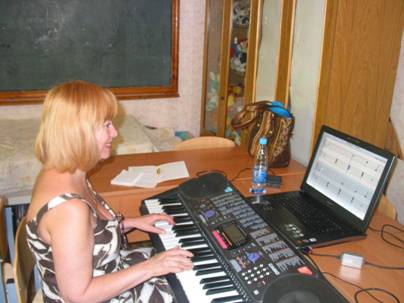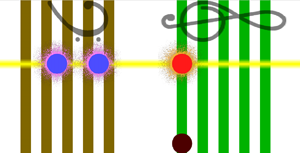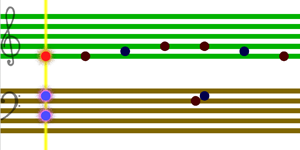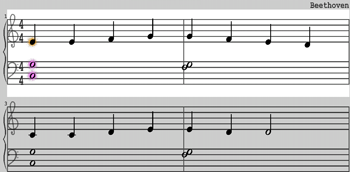 |
|
We have developed “user friendly” interfaces of sheet music for all students. Each modification corresponds with the student's level of music literacy and skill with sight-reading. We use computer interactivity, different visual hints, animation and approaches in order to make sheet music ‘readable’ for students of any age - including 2 year old toddlers! Students of any level of music proficiency can also benefit from Gentle Piano™.
Seeing mistakes to correct them.
Our music learning software helps student not only to read piano sheet music but to monitor their errors as they play.
- Students see where errors were made.
- They will also be helped to fix their mistakes.
- The student can learn a piece with separate or both hands.
- The student can also choose simpler or advanced versions of sheet music.
Improving your music memory and ear.
Gentle Piano™ helps ear training. You don’t have to be musically inclined to succeed with us. Visual interaction with music notation helps the mind have enough ‘room’ to listen to what you are playing while being in control of producing sounds. Such “hands on” experience in making music leads to developing your musical ear.
Gentle Piano™ helps memorizing. Additionally, memorization of piano pieces also won’t be a problem any longer! We've created unique ways to help you to memorize pieces. Keep in mind that with Gentle Piano™ your memory will be always secured by not only sound but also visual support.
Gentle Piano™ will interact with you directly. Interactivity in learning is crucial. This is why many students prefer to learn with a teacher. However, some tasks we prefer to master in private - especially those students intimidated by the presence of others. We think that playing notes on the piano could be something a student can manage without the help of a teacher. 
Gentle Piano™ - is a game-like sheet music with animated hints. We have developed unique visual animated hints that will give you a clue what you do right or wrong and how to fix your own mistakes. These hints are so intuitive and bold that even toddlers get them pretty quickly.
The computer “comments” on everything done at the piano - when you have to keep pressing one key and to release another, when you pressed the wrong key and how far are you from the right one, how long to hold the key down according to duration of the note and many others items.
We came to such animation after learning that visual hints are more perceptive then aural signals. Trying to manage using 10 fingers while dealing with notation, piano keys and sounds, as well as vocal commands of an instructor often is too much. You simply don’t have ‘enough room’ in your mind to process all these items. Our system of visual and animated hints helps lift work and tension from the process.
Click HERE to purchase our learning package with Gentle Piano™!
We visually 'explained' the Grand Staff for the beginner's eyes, made it interactive and provided a straight visual link between the notes and piano keys. We developed gradual changes between 'elementary' Grand Staff and original. This is why our invention works for students of any levels: you may chose the Grand Staff that you feel the most comfortable with and work out all the way to the original notation.
1. Spaces and lines are the same tracks; they were presented with the  same width on elementary level. It helps to see that the white stripes are not 'breaks' between black lines, but also a source of information.
same width on elementary level. It helps to see that the white stripes are not 'breaks' between black lines, but also a source of information.
2. Music notes are all either on spaces or on lines, they were colored in two contrast colors for beginner's eyes to instantly catch the difference.
3. Treble and Base Cleaves are two different systems. They were presented in two different colors, also, but colors of a 'tree'. It would help to explain gradual changes in pitch – from dark to light, from 'trunk' to 'crown'.
 4. Music notes go up and down and corresponding keys – right and left, they were visually lined up by turning the Grand Staff sideways in elementary presentation to help beginners to SEE a straight link between them right away.
4. Music notes go up and down and corresponding keys – right and left, they were visually lined up by turning the Grand Staff sideways in elementary presentation to help beginners to SEE a straight link between them right away.
5. Music notes have only seven names for all the keys and sounds, they were labeled with the names to help beginners to SEE the relationship easily, not struggle looking for information.
6. Starting Version 2_6 we added litghtly colored blue space between 3rd and 4th lines to indicate the beginning of the next octave (it appears or is removed by pressing a single key).
We also color-coded piano keys for you the same way with help of removable stickers or key-guides: they have green and brown stripes as well as r ed and blue circles with notes names.
ed and blue circles with notes names.
Besides the 'Elementary presentation' of music notation the gradual and logic transformation was developed in order to train eyes of beginners to see abstract music score while improving coordination.
Also we made all the changes gradual and you can use as much visual support as you need from very elementary to original music score.
Piano key sticker map for Alphabetical note names

Piano key sticker map for Italian(Solfeggio) note names
Soft Mozart uses both the Alphabetical music notation - C, D, E, F, G, A and B, and "Solfeggio" or Italian music notation - Do, Re, Mi, Fa, Sol, La and Ti.
All Italian names have special mnemonic symbols to help a student recognize and remember note names:

These symbols (for Solfeggio names) or letters (for Alphabetical names) are used throughout the Soft Mozart system to represent notes, especially at a beginner's level. As note images and key stickers, they allow the beginner to easily recognize and name any music staff note and piano key, and help even a 2-year old child to read notes and find the correct keys. Used together with music sounds, these symbols provide effective ear training by helping to recognize, to name and memorize different musical pitches.
We recommend the use of the Italian (Solfeggio) note name convention by any beginner or child. Its note symbols are very easy to identify and remember, even by those who can't read yet. And most importantly, Italian note names are specially designed for singing. The singing of note names helps any beginner to form a crucial musical skill to connect a pitch of a note with its name, and tie together his or her ear, voice and brain.

